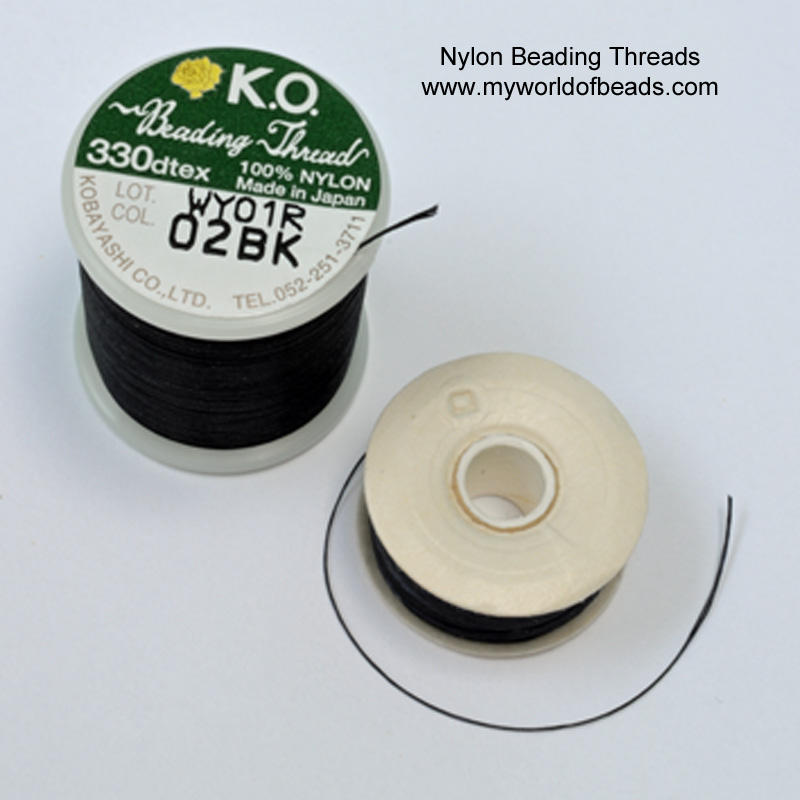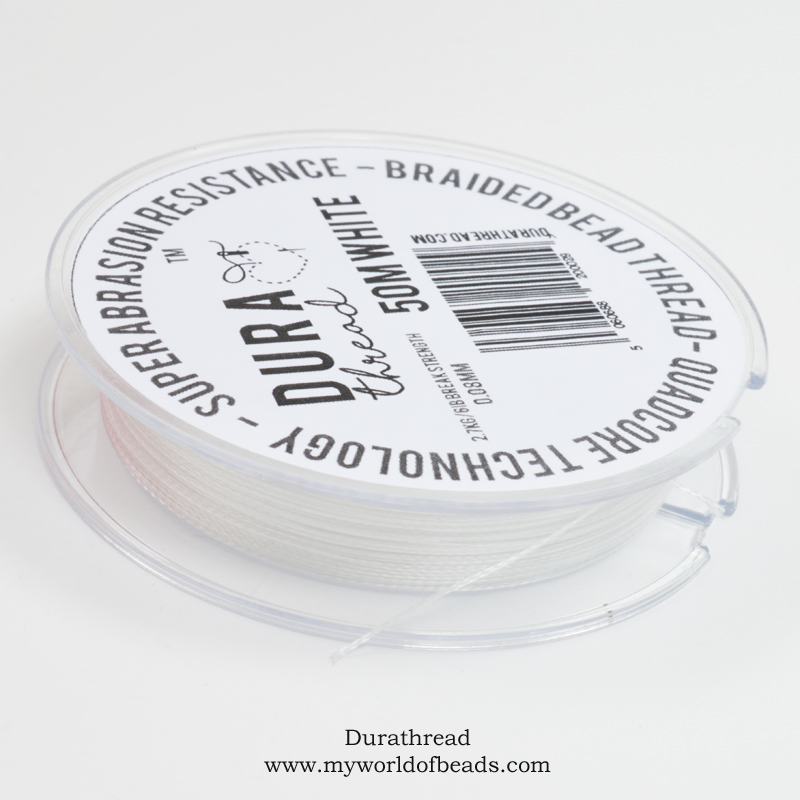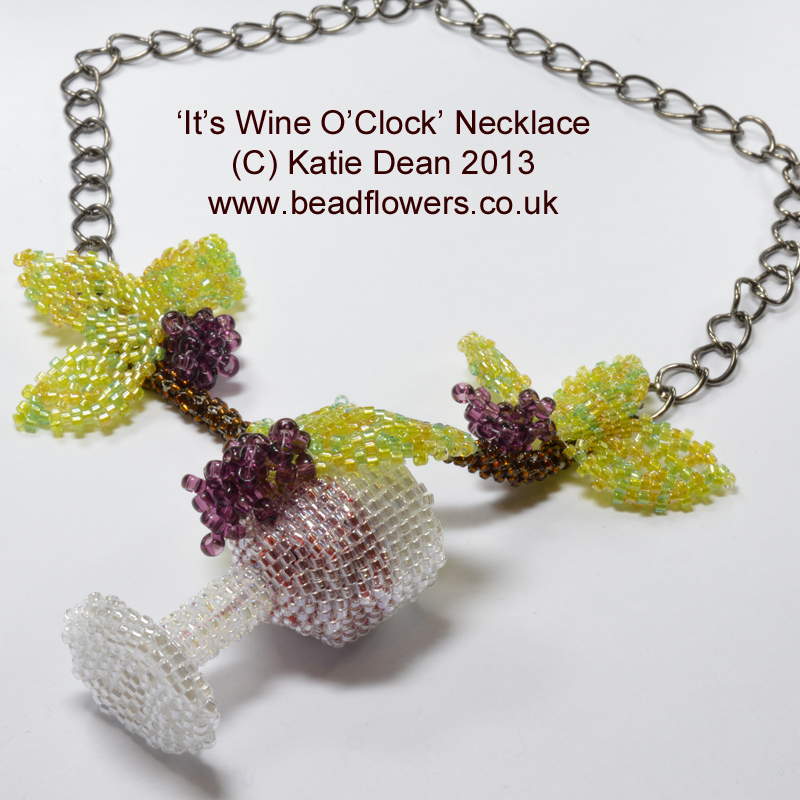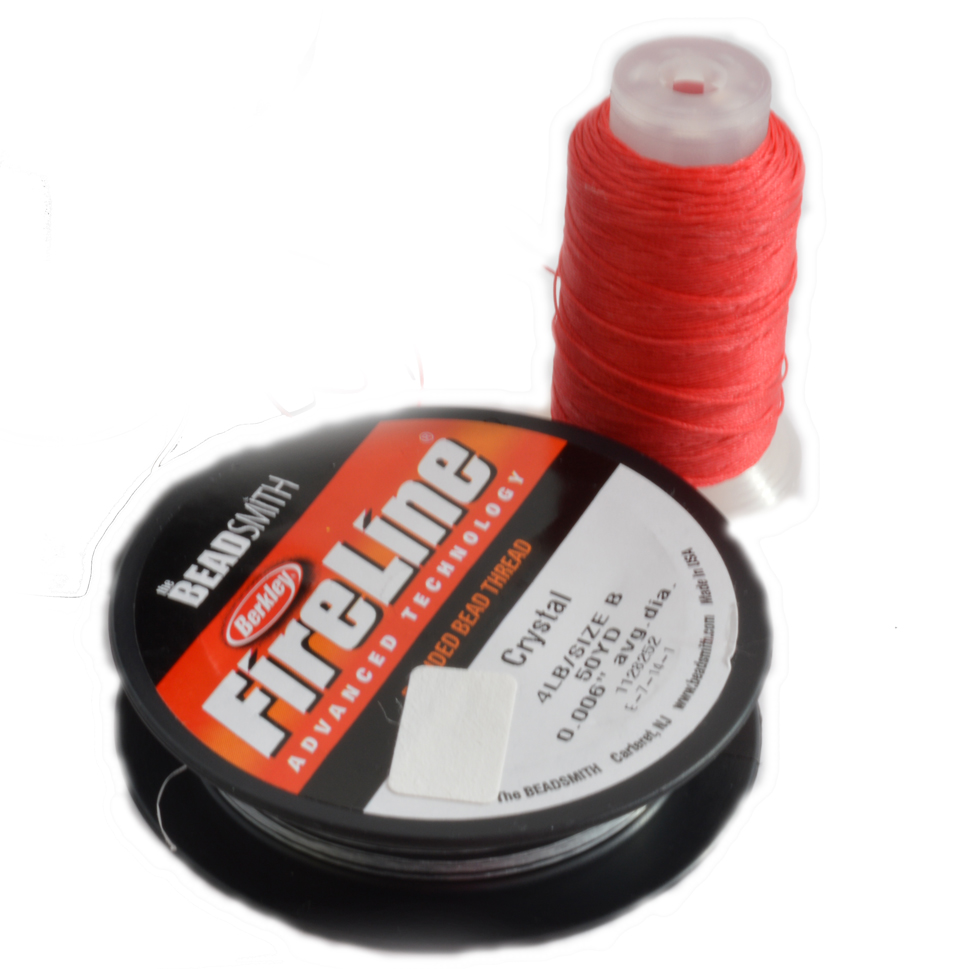How to Choose Beading Thread
I’ve chosen to write this post in answer to Jane, who asked a great question on the ‘Create Your World of Beads‘ page. Now, Jane noted that I almost always use 4lb Fireline for my beading projects. She was asking why that is and could I give some help with the issue of how to choose beading thread.
Why do I use 4lb Fireline?
Let me start by answering one part of Jane’s question. Yes, the majority of my beading patterns from the past few years have included the following in my materials list:
“Your choice of thread – I used 4lb Fireline in xxx”
So, why am I making this choice? And why am I still offering you the chance to choose beading thread of your own?
Firstly, 4lb Fireline is my go-to thread. Simply because I find it easy to use and it does the job. So, unless there is a specific reason why it wouldn’t be appropriate, I will always use it by default.
Prior to that, I would have said the same about Nymo, actually. When I started beading, Nymo was pretty much the only beading thread that was readily available in the UK. I never had a problem using it, so I never thought to try anything else. (Until years later when I was teaching my first workshop and my students laughed at me for still using Nymo…!)
So, basically, my reason for choosing Fireline has a lot to do with habit.
Which is why I usually offer you the opportunity to make your own thread selection.
This may be great if you’ve got a lot of experience, but what if you’re just starting out? If nobody has told you what to use, then how to choose beading thread can be a huge issue.

How to choose beading thread: a quick(ish) guide
Before you get on to the question of how to choose beading thread, you should be thinking about why you’re using it.
Beading thread should be serving two purposes:
- It’s an essential material to hold your beads in place
- If you’re going to enjoy the beading process, then it needs to feel pleasant to work with
So, let’s take a look at each of these and see why they matter and how they can help you make a good choice.
An essential material
Basically, most beading thread will do the job of holding the beads together very well. If it didn’t, it wouldn’t remain in the market. Nobody is going to keep on buying a material that doesn’t do its job. And, since us beaders all talk to each other a lot, if any thread brand was really useless, word would soon get out about it!
So, you can assume that if you’ve bought a beading thread, it’s going to be perfectly adequate for beading.
However, will it be the best choice? That’s really what we’re asking here.
Now, there are some basic rules that might help you. So, let’s take a look at them…in no particular order!
Rule 1
In general a monofilament-type thread (e.g. Fireline…basically, any thread that feels ‘plasticky’) is less likely to be cut by sharp-edged beads. The most notorious beads for having sharp edges are crystals. So, if your project calls for crystals, you might want to try avoiding nylon-based threads.
However, there are plenty of exceptions to that. I’ve had my Fireline cut through by sharp edges on beads. I’ve also used KO Thread plenty of times when working with crystal beads.
So, it’s still not a guaranteed ‘rule’ to follow.

Rule 2
Secondly, the monofilament-based threads tend to be a little stiffer. So, if you are creating something that needs to drape, you might be better going for a nylon-based thread.
Conversely, if you want something that is going to hold its shape well – like a 3D object – then a stiffer thread might be a better choice. However, the stiffness of your work also has a lot to do with your beading tension. So, thread may help or hinder, but it’s not the only factor to consider. I’ll elaborate on that idea in a minute.
This is why Durathread has been developed. It tries to bring the best of both worlds – the durability of a monofilament thread, and the flexibility of nylon.
Rule 3
Colour may also be a factor. Remember, beads are made from glass, so your thread will show through and impact the colour of your beads to some degree.
In some projects, that may mean it is essential for you to match the thread colour closely to your bead colour. In other projects (like my ‘It’s wine-o-clock’ necklace), the designer may choose to use a contrasting thread colour to deliberately change the colour of the beads.

Now, not all threads are available in a range of colours. So, if colour is a critical factor, that may restrict which threads you can use.
Rule 4
Next, comes strength and thickness. You will notice a lot of beading threads have a choice of thickness. In some cases, this is expressed as a letter (e.g. ‘Nymo D’ or ‘Nymo B’ …yes, D is thicker than B, as you might expect). In other cases, it is expressed as a weight (e.g. Fireline 4lb would indicate a single length of this Fireline can support 4lb weight).
Now, thicker thread or higher weight would indicate a stronger material. But do bear in mind, even a 4lb (low Fireline weight) or a fine thread is still capable of supporting far more weight than your average beads.
So, the more important consideration here is really about the beads you are using. If you are working with tiny seed beads, using thick thread will be a problem. It will quickly fill the bead hole and make your project unmanageable.
Conversely, if you are stringing a super-heavy, huge single bead as a pendant, you’ll want to go with the strongest thread because you (presumably) have plenty of room for stringing. Yet weight is your major concern.
Rule 5
This final ‘rule’ is really about availability and budget. I hope by now, you’re beginning to see that there is no one ‘right’ beading thread. All your options will do an adequate to good job when it comes to physically creating a piece of work.
So, you might be constrained by what you can find in your local bead shop, or by what you can afford. You might have purchased a kit that includes a basic thread.
Basically, I would argue that there is rarely a good reason for avoiding any kind of bead thread.
So, if they all work well, why the fuss about how to choose beading thread?

Enjoying your beading
I would argue that the most important consideration is really the second one: enjoyment.
Now, if you’re working with a thread that continually breaks, tangles and knots, you’re not going to enjoy your beading all that much.
Similarly, if you struggle to get good tension with your chosen thread, you may find your project doesn’t look the way you want. So, that’s not going to be very satisfying.
So, how do you know which thread is going to keep breaking and tangling? How do you know which one will give you the best tension? Which is going to feel most comfortable to use?
There’s only one way to find this out. Try as many different beading threads as you can.
Now, that’s probably not the answer you wanted to hear. But the truth is, there is no ‘perfect beading thread’. Personally, I find Fireline really comfortable to work with. I don’t have trouble with knots. It allows me to create the projects I want. So, that’s why I choose to use it.
And yes, since my early days of inexperience, I have tried many other beading threads. So, I’m making that judgment based on personal experience.
What I see, though, is everyone’s experience is different. I’ve seen people manage to tie Fireline in knots, but never get a tangle in Nymo. People have written to me to ask if it’s ‘ok’ for them to use Miyuki thread to make a box because they struggle to get good tension with Fireline. Of course it is!
The real answer to this question
The point here is, beading thread is personal.
I’ve made my choice because it feels comfortable to me. But I know for a fact that it isn’t comfortable to every other beader in this community.
The way you work with thread is deeply personal, just as beading tension is. It reflects a whole combination of factors like how/where you store your thread, the chemicals on your skin, the direction in which you pull your needle through the beads, the strength with which you pull, and so on. These aren’t factors you can measure or change.
So, the only true answer to how to choose beading thread is: experiment.
Get as many different beading threads as you can and try them all. You may find there is only one that you love. So, use that for everything. And yes, even if a designer has made another recommendation, it can be ok for you to use your choice of thread.
(If your project falls apart later, you might want to go back and defer to the wisdom of the designer!).
You might find that a particular thread is better for a particular type of project, or with particular beads. So, you may find you like to use a mix of different threads.
Or your experiments may show you that there isn’t any great difference. In that case, either use what the designer recommends, or use what you have on hand.
Next steps
If you want to read more about the different types of beading thread, I have a whole section here, to which I am adding posts as I try different threads.
I hope you found that helpful. If you would like to receive a free set of beading tips to improve your beading, please click here to join my mailing list. You will then get brilliant beading tips delivered direct to your inbox, completely free, every month. Oh, and a free beading pattern coupon to welcome you!











Something that I think about that you didn’t bring up is longevity. How long will these threads hold up in years? Will your thread change color? Will they become brittle and break? I really hate the thought of my beadwork falling apart in years to come.
That’s a great question, Stephanie. I’ve never had any kind of issue with longevity for any of the beading threads I’ve used. I have beadwork and jewellery that I have had on display and been wearing for 18 years plus and the thread is still holding strong. We also have plenty of samples of beadwork that dates back centuries. I have seen some Victorian era beaded bags that have some damaged threads, but that is more than 150 years on and, I’m guessing the technology used to make thread today is a lot better than what they would have been using in the nineteenth century. So, you are right to think of this, but I think the reason it isn’t talked about is it’s not really a problem. I hope that helps!
An old comment, but in case someone may find my reply useful in the future. It’s true that fireline has a certain life span, but fireline and power pro from a fisherman’s stand point are the gold standard for durability. They hold up to rough salt water fishing in the sun here in hawaii, and so the day to day wearing of threads should be easily handled. I can tell you this too, that generic braid from amazon such as “angry fish” braid in the context of fishing does not hold up the same way fireline and power pro do. You definitely 100 get what you pay for.
I’m a fisherman looking for anklet materials personally which is how I cam across this article. Making an anklet for the girlfriend and was trying to find if there were other options besides fireline and power pro and the griffin silk i’ve been using.
Thank you for sharing your knowledge – it’s lovely to hear about Fireline and Power Pro from the perspective of someone who uses it for fishing as well as beading!
Very informative article. It was well written. Thank you.
Thank you for your kind comment Carolyn – I’m happy to have helped.
Nice article.
I got a lot of information about how can I choose beading thread and other materials as well.
I am replicating costumes from a movie, that are covered in glass bugle beads! The smaller size beads aren’t really the issue. It’s the 1-1/4″ bugle beads that keep cutting the thread. And these beads are TIGHTLY PACKED TOGETHER. There is maybe 1/32″ in between them. Is there a thread I can use that won’t get cut by the edge of the beads?
These are beaded appliques, that are later sewn onto a finished garment. And gluing these beads down is not an option. They just fly off in different directions.
That sounds like a wonderful project! Yes, I can see that working with the bugle beads would be challenging in this scenario. When I am using beads that have sharp edges that cut through thread, I would work with Fireline. My only caveat would be that this is a stiffer thread, so I don’t normally us it for bead embroidery on fabric. A few other options: making multiple passes through the bead can help – that way if a single thread gets cut, there is still something holding the bead in place. Not a perfect solution, but something to consider. This next idea may not be applicable if you are needing to replicate a costume exactly, but… In beading, when I am working with bugle beads, I like to add a tiny seed bead (size 11, maybe even size 15) to either end of the bugle. That tiny additional bead will protect the thread from being in direct contact with the sharp edges of the bugles. In a project such as you are describing, that would mean that for each stitch, instead of just picking up 1 bugle, I would pick up 1 seed bead, 1 bugle, 1 seed bead and then stitch all three beads into place, treating them as one (I hope that makes sense).
I hope some of those thoughts are helpful. Good luck with the project – it’s going to look amazing!
Is K.O. beading thread 02 thicker than 20?
I haven’t seen KO thread described in those terms. The thickness is normally measured in mm and the standard is 0.015mm. So, I can’t be sure what the numbers 02 and 20 are referring to. Ordinarily, I would expect that could be a reference to the colour rather than the thickness. You would be best to contact the supplier offering this and ask them direct – sometimes individual shops or suppliers put their own coding on items, which may not be “industry standard”. So, if in doubt, always ask the shop selling the item! (And if you can’t make direct contact with the supplier, perhaps be wary of purchasing there!)
Thanks Guys For Sharing Guys I have been struggling to choose the rights Threads for my Beading God bless you all and let’s keep on Beading
You’re welcome! I’m glad you found this helpful. Happy beading!